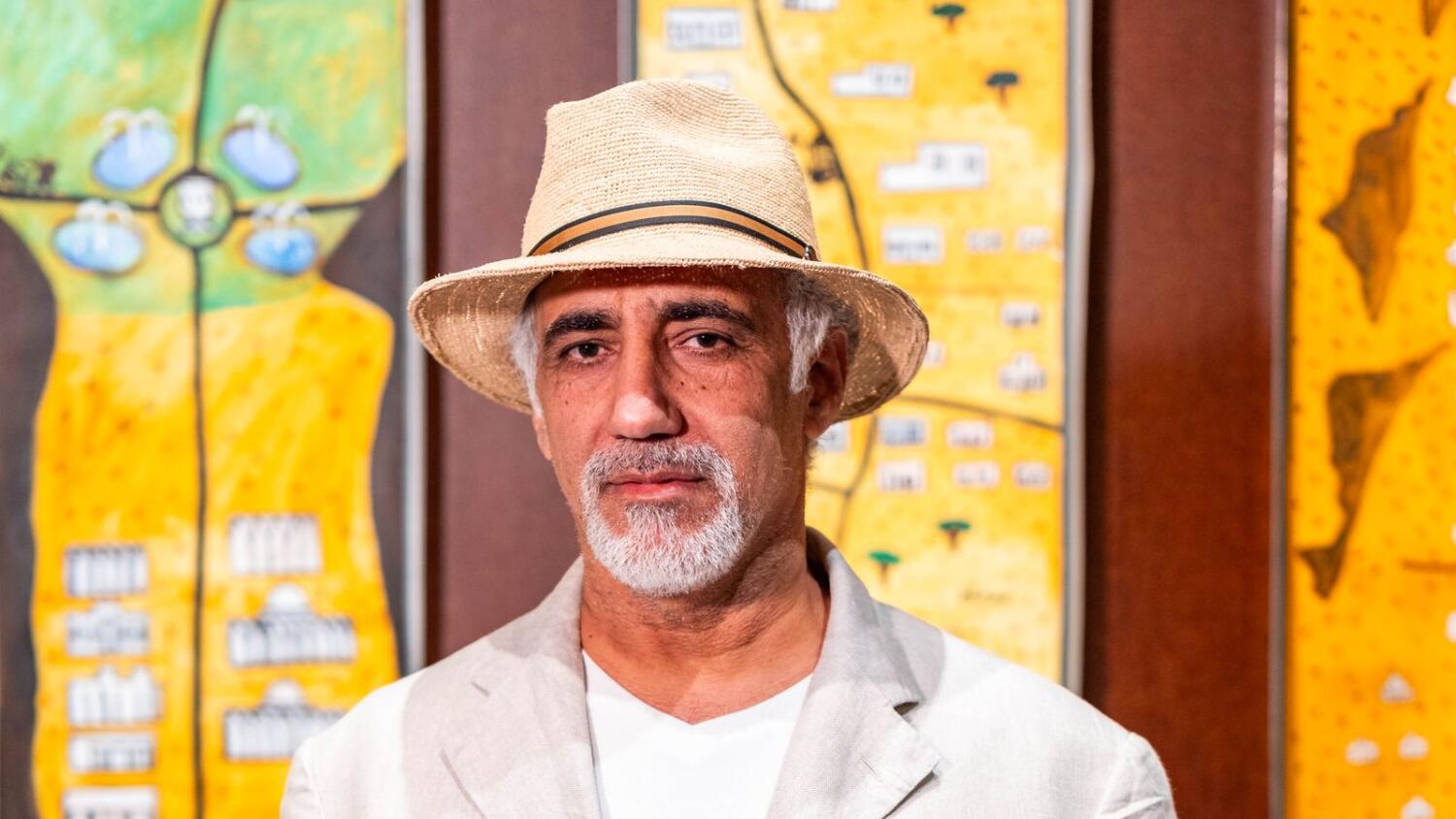Inside the workshop of UAE-based artist Abdullah Al Saadi at the 60th Venice Art Biennale
- byAdmin
- Jul 2, 2024
- 10 months ago

One of the leading conceptual painters in the United Arab Emirates, Abdullah Al Saadi is renowned for his work that combines a profound sense of mystery with familiarity. But at his core, he's still a devoted nomad. In addition, he is a poet, storyteller, memory keeper, and self-described "lover of nature." So, it should come as no surprise to see the 57-year-old veteran Emirati at the newly started Venice Art Biennale 2024 wearing a beige linen suit and matching hat—all dressed, it seems, to go on one of his famously daring 'journeys' and fully immerse himself in the creative process.
Situated in the picturesque Khor Fakkan, where he was born and continues to reside, Al Saadi is the representative of the United Arab Emirates at the 60th International Venice Biennale. Adriano Pedrosa is the curator of the pavilion, which is themed 'Stranieri Ovunque — Foreigners Everywhere.'
The title of Al Saadi's solo exhibition at the Venice Biennale, "Sites of Memory, Sites of Amnesia," focuses on the interdependence between art and real experience. More importantly, it draws attention to the artist's function as a conduit for recollections, the complex conundrum of what to cherish and discard, what to remember and forget, and maybe even if the exploits of a single man might point us in the direction of a common and universal humanity.The timeless quote by Milan Kundera, "The struggle of man against power is the struggle of memory against forgetting," comes to mind when viewing Al Saadi's creations.
"Sites of Memory, Sites of Amnesia," curated by Tarek Abou El Fetouh of Sharjah, is currently on display at Arsenale in Venice, a former military shipyard complex that serves as one of the biennale's main venues along with the nearby Napoleon-era Giardini. This exhibition once again places the UAE and its extraordinary artistic output at the forefront of the global art scene. The UAE pavilion has been transformed into a replica of Al Saadi's studio in Khor Fakkan, thanks to the creative idea of Al Saadi and El Fetouh. It features over 450 artworks, documents, letters, and poetry-infused remembrances, along with performers who recreate the rituals that Al Saadi himself often engages in at his cosy and welcoming workspace in the untamed landscapes of his native country.
The display details Al Saadi's eight distinct journeys over the years. When seen in this comprehensive manner, the artist conveys his stories with a distinct voice, frequently giving animals and artefacts he carried with him on his travels a voice. The several chapters of each story culminate in a new twist, providing biennale attendees with a comprehensive and dynamic understanding of Al Saadi's artistic technique.
"In 1992, I had a dream of riding a bicycle around the world, but I was unable to fulfil it. As a result, I decided to showcase my experiences travelling through the wilderness on a bicycle, by foot, or often with animals as travel companions through 'Sites of Memory, Sites of Amnesia.'" "My passion and love for the UAE's rural areas, their people, and their natural surroundings have inspired all of this," Al Saadi tells wknd. at his press preview for his show on a chilly April morning in Venice. In fact, several of the paintings on show show a bicycle making its way through what appears to be an oasis surrounded by palm trees. The pencil drawings in The Sufi's Journey by Bicycle are created by the artist with a youthful enthusiasm.
"I debuted these pieces in a Pakistani biennale for the first time. Sufi concepts are significant to me since they emphasise humanity's unity," he muses.
The primary source for The Sufi's Journey by Bicycle is Al Saadi's meticulously kept notebooks, which he kept throughout his life. His lifelong passion with writing is also evident in the pieces, especially in light of his respect for Arabic poetry and Sufism. Notably, he likes to collect abandoned tin boxes, which are where these extraordinary artwork were meticulously kept. He records road layouts and trails with 85 tiny stones and boulders in The Slipper's Journey. Admittedly, Al Saadi's journals resemble a "vast library of memories." He supposedly marks all of his metal boxes precisely and keeps them sealed, and he keeps a diary every day.
The metal containers allow him to "document, archive and organise my artworks, so that they are within easy reach whenever I need them." The curator El Fetouh has set aside room for sizable, intricately painted metal boxes at one end of the "Sites of Memory, Sites of Amnesia." To get access to the artist's most personal and reflective ideas, visitors are urged to ask volunteers for help in unlocking them. "I wanted to show the sizeable intensity and ambition of Abdullah's vision," the artist says. He creates art frequently.
There are 456 artworks throughout the eight voyages that are on display in the show. A portion of them were on display in vitrines as part of a museum exhibit, but the others were kept concealed in the large metal chests that the artist keeps at his workspace. In addition to being an independent curator, El Fetouh also holds the position of director of performance at the Sharjah Art Foundation. "We wanted to re-stage the rituals of opening these metal chests to show scrolls, stones, and old used sweet tins by the presence of actors for the whole duration of the exhibition," she says. El Fetouh continues, "Abdullah does not represent all spatial components of the terrain throughout his excursions in his sketches and paintings. Through an intricate creative, sensory, and cognitive process, he selects which locations to reveal and which to keep hidden. For instance, he just completed a metal container with levers that only permits a partial view of the countryside as part of a commission for the present show. In addition to reflecting his travels around the surrounding countryside of his city, Khor Fakkan, rolling the canvas brings attention to the shifting boundaries between locations to forget and sites of remembrance."
Madha, a hilly town near Khor Fakkan, is home to Al Saadi's studio. "The metal boxes with codes, numbers, dates, and other information are an integral element of his artistic process; the space is sacred to him and vital to his work. They are more than just boxes to hold the work. Because of this, I thought it was crucial to bring this mood into the exhibition by having people open these chests and view the artwork in the same way that the artist does in his studio," the curator explains.
Al Saadi remembers that when he was a student in Japan, he got interested in collecting tin boxes. "In order to recall everything I had drank, I used to collect cans, bottles, and other items. It became become a habit later on," he chuckles. The Purl and Silk Journey, which are diaries shown on lengthy vertical scrolls and were inspired by his studies of the Silk Road, and A Journey in the Footsteps of Camar Cande are two of the most notable pieces in Sites of Memory, Sites of Amnesia. Al Saadi ventured into the wilderness in 2011 with a donkey, travelling through isolated locations including Nahwa, Shis, Taybah, and Masafi, among many others. A experience in the Footsteps of Camar Cande was inspired by this experience. The primary theme of Al Saadi's artwork is animals. El Fetouh notes, "Camar Cande has two travels in the show. Given that the donkey was white, the name Camar Cande (which means moon in Spanish) was given to it. Abdullah's perspective is significantly influenced by friends such as Camar Cande. He follows in the footsteps of gentle creatures, such as dogs and donkeys, who appear to have deep wisdom and an innate sense of the terrain. Abdullah's perspective of the universe is altered by the existence of animals."
Artists are inspired to create while they are in nature. He traces his mother's profound appreciation of nature to her. He was raised on a farm in Madha. He honoured his mother in My Mother's Letters, one of his more well-liked television shows (1998–2000). It's not on exhibit in Venice and is a much older piece of art. It was thought to have been influenced by items his uneducated mother would regularly leave for him at his studio as a memento of her visits while his absence. "Abdullah exhibits a different understanding of nature as the classical Arab poet understood — as vast terrain of beings," says El Fetouh. "A book, an animal, or a mode of transportation accompany him while he journeys alone. He doesn't begin to write, paint, or sketch until he is completely engrossed in the outdoors and its surroundings.
"Sites of Memory, Sites of Amnesia," commissioned by the Salama Bint Hamdan Al Nahyan Foundation and supported by the UAE Ministry of Culture, is the ideal way for people all over the world to become familiar with the renowned artist Al Saadi. He has, however, previously shown in the Venice Biennale, so he is no stranger to the venue. El Fetouh claims that because Abdullah Al Saadi is regarded as a significant player in the UAE art scene, he was an obvious option for the Venice showcase. "Abdullah is one of the pioneering conceptual artists who, in the 1980s, bolstered the contemporary art scene in the UAE and influenced a generation of artists in the whole region," says the curator. Hassan Sharif, Mohamed Ahmed Ibrahim, Mohamed Kazem, and other influential figures helped establish conceptual art practices, question established conventions, and provide a path for next generations of artists and curators in the UAE and several other nations in the region. In our exhibition book, Abdullah penned his own biography, narrating all the tales of this era through pictures and a rundown of the concerts they performed."
El Fetouh agrees that UAE-produced art is currently receiving a lot of attention in the West. Additional proof of the Gulf's growing soft power is the positive response the UAE pavilion received at the esteemed Venice Biennale. El Fetouh is as proud of the thriving art culture back home, having shaped the Middle Eastern art landscape himself.
"Dubai has developed into a significant hub for knowledge in the area, home to several artists, curators, exhibits, and programmes. In Abu Dhabi, large museums are being constructed. In addition to the Sharjah Biennial and the popular shows at the Sharjah Art Foundation, we have prestigious art fairs like Art Dubai and Abu Dhabi Art. With all of its projects, foundations, and organisations, Dubai's Al Serkal Avenue is a bustling area. Subsequently, there was the novel public art initiative that I had the honour of initiating for Expo Dubai 2020. Since then, a lot more have done the same," he says. He smiles and says, "It's a good moment for art in the region."
The 60th Venice Art Biennale will take place from April 20, 2024, to November 24, 2024.
Post a comment
Hot Categories
Recent News
Pre-Christmas Magic: Getting Ready for the Festive Season with Realtime Brief
- Nov 28, 2024
- 5 months ago
The Future of Cryptocurrency: Exploring Opportunities and Challenges
- Jul 12, 2024
- 10 months ago
Daily Newsletter
Get all the top stories from Blogs to keep track.







0 comments